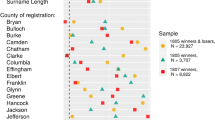Abstract
This paper builds upon previous work on the economics of lottery adoption by incorporating the collective action logic developed in an important series of works by Mancur Olson. Public choice research points out that legislators are rational maximizers, and act within a costbenefit framework in attempting to implement means of budget finance. Discrete-time hazard models presented suggest that lottery adoption is more likely to occur in older states where rent seeking groups are older and more organized, and can more effectively engage in efforts for collective action (and benefits). By implementing lotteries as taxshifting mechanisms, the role of, government and the direction of social evolution are also altered.
Similar content being viewed by others
References
Brinner, R.E. and C.T. Clotfelter. (1975) “An Economic Appraisal of State Lotteries,”National Tax Journal 32: 543–548.
Caudill, S.B., J.M. Ford, F.G. Mixon, Jr. and T.C. Peng. (1995) “A Discrete-Time Hazard Model of Lottery Adoption,”Applied Economics 27: 555–561.
Filer, J.E., D.L. Moak, and B. Uze. (1988) “Why Some States Adopt Lotteries and Others Don’t,”Public Finance Quarterly 16: 259–283.
Jackson, J.D., D.S. Saurman, and W.F. Shughart, II. (1994) “Instant Winners: Legal Change and Diffusion of State Lotteries,”Public Choice 80: 245–264.
Lipford, Jody and Bruce Yandle. (1990) “Exploring Dominant State Governments,”Journal of Institutional and Theoretical Economics 146: 561–575.
Livernois, J.R.. (1987) “The Redistributive effects of Lotteries: Evidence from Canada,”Public Finance Quarterly 15: 339–351.
Martin, R. and B. Yandle. (1990) “State Lotteries as Duopoly Transfer Mechanisms,”Public Choice 64: 253–264.
Olson, M. (1988) “The Productivity Slowdown, the Oil Shocks, and the Real Cycle,”Journal of Economic Perspectives 2: 43–69.
— (1983) “The South will Fall Again: The South as Leader and Laggard in Economic Growth,”Southern Economic Journal 49:917–932.
— (1982)The Rise and Decline of Nations, New Haven, CT: Yale University Press.
— (1965)The Logic of Collective Action: Public Goods and the Theory of Groups, Cambridge, MA: Harvard University Press.
Wohlenberg, E.H. (1992) “Recent U.S. Gambling Legalization: A Case of State Lotteries,”The Social Science Journal 29: 167–183.
Author information
Authors and Affiliations
Rights and permissions
About this article
Cite this article
Mixon, F.G., Caudill, S.B., Ford, J.M. et al. The rise (or fall) of lottery adoption within the logic of collective action: Some empirical evidence. J Econ Finance 21, 43–49 (1997). https://doi.org/10.1007/BF02929021
Issue Date:
DOI: https://doi.org/10.1007/BF02929021



